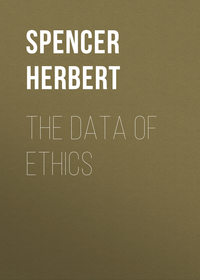 полная версия
полная версияIllustrations of Universal Progress: A Series of Discussions
Throughout the above argument, it is tacitly assumed that differences of apparent magnitude among the stars, result mainly from differences of distance. On this assumption the current doctrines respecting the nebulæ are founded; and this assumption is, for the nonce, admitted in each of the foregoing criticisms. From the time, however, when it was first made by Sir W. Herschel, this assumption has been purely gratuitous; and it now proves to be totally inadmissible. But, awkwardly enough, its truth and its untruth are alike fatal to the conclusions of those who argue after the manner of Humboldt. Note the alternative.
On the one hand, what follows from the untruth of the assumption? If apparent largeness of stars is not due to comparative nearness, and their successively smaller sizes to their greater and greater degrees of remoteness, what becomes of the inferences respecting the dimensions of our sidereal system and the distances of nebulæ? If, as has lately been shown, the almost invisible star 61 Cygni has a greater parallax than α Cygni, though, according to an estimate based on Sir W. Herschel's assumption, it should be about twelve times more distant – if, as it turns out, there exist telescopic stars which are nearer to us than Sirius; of what worth is the conclusion that the nebulæ are very remote, because their component luminous masses are made visible only by high telescopic powers? Clearly, if the most brilliant star in the heavens and a star that cannot be seen by the naked eye, prove to be equidistant, relative distances cannot be in the least inferred from relative visibilities. And if so, nebulæ may be comparatively near, though the starlets of which they are made up appear extremely minute.
On the other hand, what follows if the truth of the assumption be granted? The arguments used to justify this assumption in the case of the stars, equally justify it in the case of the nebulæ. It cannot be contended that, on the average, the apparent sizes of the stars indicate their distances, without its being admitted that, on the average, the apparent sizes of the nebulæ indicate their distances – that, generally speaking, the larger are the nearer, and the smaller are the more distant. Mark, now, the necessary inference respecting their resolvability. The largest or nearest nebulæ will be most easily resolved into stars; the successively smaller will be successively more difficult of resolution; and the irresolvable ones will be the smallest ones. This, however, is exactly the reverse of the fact. The largest nebulæ are either wholly irresolvable, or but partially resolvable under the highest telescopic powers; while a great proportion of quite small nebulæ, are easily resolved by far less powerful telescopes. An instrument through which the great nebula in Andromeda, two and a half degrees long and one degree broad, appears merely as a diffused light, decomposes a nebula of fifteen minutes diameter into twenty thousand starry points. At the same time that the individual stars of a nebula eight minutes in diameter are so clearly seen as to allow of their number being estimated, a nebula covering an area five hundred times as great shows no stars at all. What possible explanation can be given of this on the current hypothesis?
Yet a further difficulty remains – one which is, perhaps, still more obviously fatal than the foregoing. This difficulty is presented by the phenomena of the Magellanic clouds. Describing the larger of these, Sir John Herschel says: —
"The nubecula major, like the minor, consists partly of large tracts and ill-defined patches of irresolvable nebula, and of nebulosity in every stage of resolution, up to perfectly resolved stars like the Milky Way; as also of regular and irregular nebulæ properly so called, of globular clusters in every stage of resolvability, and of clustering groups sufficiently insulated and condensed to come under the designation of 'cluster of stars.'" – "Cape Observations," p. 146.
In his "Outlines of Astronomy," Sir John Herschel, after repeating this description in other words, goes on to remark that —
"This combination of characters, rightly considered, is in a high degree instructive, affording an insight into the probable comparative distance of stars and nebulæ, and the real brightness of individual stars as compared with one another. Taking the apparent semi-diameter of the nubecula major at three degrees, and regarding its solid form as, roughly speaking, spherical, its nearest and most remote parts differ in their distance from us by a little more than a tenth part of our distance from its centre. The brightness of objects situated in its nearer portions, therefore, cannot be much exaggerated, nor that of its remoter much enfeebled, by their difference of distance. Yet within this globular space we have collected upwards of six hundred stars of the seventh, eighth, ninth, and tenth magnitude, nearly three hundred nebulæ, and globular and other clusters of all degrees of resolvability, and smaller scattered stars of every inferior magnitude, from the tenth to such as by their magnitude and minuteness constitute irresolvable nebulosity, extending over tracts of many square degrees. Were there but one such object, it might be maintained without utter improbability that its apparent sphericity is only an effect of foreshortening, and that in reality a much greater proportional difference of distance between its nearer and more remote parts exists. But such an adjustment, improbable enough in one case, must be rejected as too much so for fair argument in two. It must, therefore, be taken as a demonstrated fact, that stars of the seventh or eighth magnitude, and irresolvable nebula, may co-exist within limits of distance not differing in proportion more than as nine to ten." – "Outlines of Astronomy," pp. 614, 615.
Now, we think this supplies a reductio ad absurdum of the doctrine we are combating. It gives us the choice of two incredibilities. If we are to believe that one of these nebulæ is so remote that its hundred thousand stars look like a milky spot, invisible to the naked eye; we must also believe that there are single stars so enormous that though removed to this same distance they remain visible. If we accept the other alternative, and say that many nebulæ are no further off than our own stars of the eighth magnitude; then it is requisite to say that at a distance not greater than that at which a single star is still faintly visible to the naked eye, there may exist a group of a hundred thousand stars which is invisible to the naked eye. Neither of these positions can be entertained. What, then, is the conclusion that remains? This, only: – that the nebulæ are not further off from us than parts of our own sidereal system, of which they must be considered members; and that when they are resolvable into discrete masses, these masses cannot be considered as stars in anything like the ordinary sense of that word.
And now, having seen the untenability of this idea, rashly espoused by sundry astronomers, that the nebulæ are extremely remote galaxies; let us consider whether the various appearances they present are not reconcileable with the Nebular Hypothesis.
Given a rare and widely-diffused mass of nebulous matter, having a diameter, say as great as the distance from the Sun to Sirius,10 what are the successive changes that will take place in it? Mutual gravitation will approximate its atoms; but their approximation will be opposed by atomic repulsion, the overcoming of which implies the evolution of heat. As fast as this heat partially escapes by radiation, further approximation will take place, attended by further evolution of heat, and so on continuously: the processes not occurring separately as here described, but simultaneously, uninterruptedly, and with increasing activity. Eventually, this slow movement of the atoms towards their common centre of gravity, will bring about phenomena of another order.
Arguing from the known laws of atomic combination, it will happen that when the nebulous mass has reached a particular stage of condensation – when its internally-situated atoms have approached to within certain distances, have generated a certain amount of heat, and are subject to a certain mutual pressure (the heat and pressure both increasing as the aggregation progresses); some of them will suddenly enter into chemical union. Whether the binary atoms so produced be of kinds such as we know, which is possible; or whether they be of kinds simpler than any we know, which is more probable; matters not to the argument. It suffices that molecular combination of some species will finally take place. When it does take place, it will be accompanied by a great and sudden disengagement of heat; and until this excess of heat has escaped, the newly-formed binary atoms will remain uniformly diffused, or, as it were, dissolved in the pre-existing nebulous medium.
But now mark what must by-and-by happen. When radiation has adequately lowered the temperature, these binary atoms will precipitate; and having precipitated, they will not remain uniformly diffused, but will aggregate into flocculi: just as water, when precipitated from air, collects into clouds. This à priori conclusion is confirmed by the observation of those still extant portions of nebulous matter which constitute comets; for, "that the luminous part of a comet is something in the nature of a smoke, fog, or cloud, suspended in a transparent atmosphere, is evident," says Sir John Herschel.
Concluding, then, that a nebulous mass will, in course of time, resolve itself into flocculi of precipitated denser matter, floating in the rarer medium from which they were precipitated, let us inquire what will be the mechanical results. We shall find that they will be quite different from those occurring in the original homogeneous mass; and also quite different from those which would occur among discrete masses dispersed through empty space. Bodies dispersed through empty space, would move in straight lines towards their common centre of gravity. So, too, would bodies dispersed through a resisting medium, provided they were spherical, or of forms presenting symmetrical faces to their lines of movement. But irregular bodies dispersed through a resisting medium, will not move in straight lines towards their common centre of gravity. A mass which presents an irregular face to its line of movement through a resisting medium, must necessarily be deflected from its original course, by the unequal reactions of the medium on its different sides. Hence each flocculus, as by analogy we term one of these precipitated masses of gas or vapour, will acquire a movement, not towards the common centre of gravity, but towards one or other side of it; and this oblique movement, accelerated as well as changed in direction by the increasing centripetal force, but retarded by the resisting medium, will result in a spiral, ending in the common centre of gravity. Observe, however, that this conclusion, valid as far as it goes, by no means proves a common spiral movement of all the flocculi; for as they must not only be varied in their forms, but disposed in all varieties of position, their respective movements will be deflected, not towards one side of the common centre of gravity, but towards various sides. How then can there result a spiral movement common to them all? Very simply. Each flocculus, in describing its spiral course, must give motion to the rarer medium through which it is moving.
Now, the probabilities are infinity to one against all the respective motions thus impressed on this rarer medium, exactly balancing each other. And if they do not balance each other, the inevitable result must be a rotation of the whole mass of the rarer medium in one direction. But preponderating momentum in one direction, having caused rotation of the medium in that direction, the rotating medium must in its turn gradually arrest such flocculi as are moving in opposition, and impress its own motion upon them; and thus there will ultimately be formed a rotating medium with suspended flocculi partaking of its motion, while they move in converging spirals towards the common centre of gravity.
Before comparing these conclusions with the facts, let us pursue the reasoning a little further, and observe the subordinate actions, and the endless modifications which will result from them. The respective flocculi must not only be drawn towards their common centre of gravity, but also towards neighbouring flocculi. Hence the whole assemblage of flocculi will break up into subordinate groups: each group concentrating towards its local centre of gravity, and in so doing acquiring a vortical movement, like that subsequently acquired by the whole nebula. Now, according to circumstances, and chiefly according to the size of the original nebulous mass, this process of local aggregation will produce various results. If the whole nebula is but small, the local groups of flocculi may be drawn into the common centre of gravity before their constituent masses have coalesced with each other. In a larger nebula, these local aggregations may have concentrated into rotating spheroids of vapour, while yet they have made but little approach towards the general focus of the system. In a still larger nebula, where the local aggregations are both greater and more remote from the common centre of gravity, they may have condensed into masses of molten matter before the general distribution of them has greatly altered. In short, as the conditions in each case determine, the discrete masses produced may vary indefinitely in number, in size, in density, in motion, in distribution.
And now let us return to the visible characters of the nebulæ, as observed through modern telescopes. Take first the description of those nebulæ which, by the hypothesis, must be in an early stage of evolution.
"Among the irregular nebulæ," says Sir John Herschel, "may be comprehended all which, to a want of complete, and in most instances, even of partial resolvability by the power of the 20-feet reflector, unite such a deviation from the circular or elliptic form, or such a want of symmetry (with that form) as preclude their being placed in Class 1, or that of regular nebulæ. This second class comprises many of the most remarkable and interesting objects in the heavens, as well as the most extensive in respect of the area they occupy."
And, referring to this same order of objects, M. Arago says: – "The forms of very large diffuse nebulæ do not appear to admit of definition; they have no regular outline."
Now this coexistence of largeness, irresolvability, irregularity, and indefiniteness of outline, is extremely significant. The fact that the largest nebulæ are either irresolvable or very difficult to resolve, might have been inferred à priori; seeing that irresolvability, implying that the aggregation of precipitated matter has gone on to but a small extent, will be found in nebulæ of wide diffusion. Again, the irregularity of these large, irresolvable nebulæ, might also have been expected; seeing that their outlines, compared by Arago to "the fantastic figures which characterize clouds carried away and tossed about by violent and often contrary winds," are similarly characteristic of a mass not yet gathered together by the mutual attraction of its parts. And once more, the fact that these large, irregular, irresolvable nebulæ have indefinite outlines – outlines that fade off insensibly into surrounding darkness – is one of like meaning.
Speaking generally (and of course differences of distance negative anything beyond an average statement), the spiral nebulæ are smaller than the irregular nebulæ, and more resolvable; at the same time that they are not so small as the regular nebulæ, and not so resolvable. This is as, according to the hypothesis, it should be. The degree of condensation causing spiral movement, is a degree of condensation also implying masses of flocculi that are larger, and therefore more visible, than those existing in an earlier stage. Moreover, the forms of these spiral nebulæ are quite in harmony with the explanation given. The curves of luminous matter which they exhibit, are not such as would be described by more or less discrete masses starting from a state of rest, and moving through a resisting medium to a common centre of gravity; but they are such as would be described by masses having their movements modified by the rotation of the medium.
In the centre of a spiral nebula is seen a mass both more luminous and more resolvable than the rest. Assume that, in process of time, all the spiral streaks of luminous matter which converge to this centre are drawn into it, as they must be; assume further, that the flocculi or other discrete bodies constituting these luminous streaks aggregate into larger masses at the same time that they approach the central group, and that the masses forming this central group also aggregate into larger masses (both which are necessary assumptions); and there will finally result a more or less globular group of such larger masses, which will be resolvable with comparative ease. And, as the coalescence and concentration go on, the constituent masses will gradually become fewer, larger, brighter, and more densely collected around the common centre of gravity. See now how completely this inference agrees with observation. "The circular form is that which most commonly characterizes resolvable nebulæ," writes Arago. "Resolvable nebulæ," says Sir John Herschel, "are almost universally round or oval." Moreover, the centre of each group habitually displays a closer clustering of the constituent masses than elsewhere; and it is shown that, under the law of gravitation, which we know extends to the stars, this distribution is not one of equilibrium, but implies progressing concentration. While, just as we inferred that, according to circumstances, the extent to which aggregation has been carried must vary; so we find that, in fact, there are regular nebulæ of all degrees of resolvability, from those consisting of innumerable minute discrete masses, to those in which there are a few large bodies worthy to be called stars.
On the one hand, then, we see that the notion, of late years uncritically received, that the nebulæ are extremely remote galaxies of stars like those which make up our own Milky Way, is totally irreconcileable with the facts – involves us in sundry absurdities. On the other hand, we see that the hypothesis of nebular condensation harmonizes with the most recent results of stellar astronomy: nay more – that it supplies us with an explanation of various appearances which in its absence would be incomprehensible.
Descending now to the Solar System, let us consider first a class of phenomena in some sort transitional – those offered by comets. In comets we have now existing a kind of matter like that out of which, according to the Nebular Hypothesis, the Solar System was evolved. For the explanation of them, we must hence go back to the time when the substances forming the sun and planets were yet unconcentrated.
When diffused matter, precipitated from a rarer medium, is aggregating, there are certain to be here and there produced small flocculi, which, either in consequence of local currents or the conflicting attractions of adjacent masses, remain detached; as do, for instance, minute shreds of cloud in a summer sky. In a concentrating nebula these will, in the great majority of cases, eventually coalesce with the larger flocculi near to them. But it is tolerably evident that some of the remotest of these small flocculi, formed at the outermost parts of the nebula, will not coalesce with the larger internal masses, but will slowly follow without overtaking them. The relatively greater resistance of the medium necessitates this. As a single feather falling to the ground will be rapidly left behind by a pillow-full of feathers; so, in their progress to the common centre of gravity, will the outermost shreds of vapour be left behind by the great masses of vapour internally situated. But we are not dependent merely on reasoning for this belief. Observation shows us that the less concentrated external parts of nebulæ, are left behind by the more concentrated, internal parts. Examined through high powers, all nebulæ, even when they have assumed regular forms, are seen to be surrounded by luminous streaks, of which the directions show that they are being drawn into the general mass. Still higher powers bring into view still smaller, fainter, and more widely-dispersed streaks. And it cannot be doubted that the minute fragments which no telescopic aid makes visible, are yet more numerous and widely dispersed. Thus far, then, inference and observation are at one.
Granting that the great majority of these outlying portions of nebulous matter will be drawn into the central mass long before it reaches a definite form, the presumption is that some of the very small, far-removed portions will not be so; but that before they arrive near it, the central mass will have contracted into a comparatively moderate bulk. What now will be the characters of these late-arriving portions?
In the first place, they will have extremely eccentric orbits. Left behind at a time when they were moving towards the centre of gravity in slightly-deflected lines, and therefore having but very small angular velocities, they will approach the central mass in greatly elongated ellipses; and rushing round it will go off again into space. That is, they will behave just as we see comets do; whose orbits are usually so eccentric as to be indistinguishable from parabolas.
In the second place, they will come from all parts of the heavens. Our supposition implies that they were left behind at a time when the nebulous mass was of irregular shape, and had not acquired a definite rotary motion; and as the separation of them would not be from any one surface of the nebulous mass more than another, the conclusion must be that they will come to the central body from various directions in space. This, too, is exactly what happens. Unlike planets, whose orbits approximate to one plane, comets have orbits that show no relation to each other; but cut the plane of the ecliptic at all angles.
In the third place, applying the reasoning already used, these remotest flocculi of nebulous matter will, at the outset, be deflected from their straight courses to the common centre of gravity, not all on one side, but each on such side as its form determines. And being left behind before the rotation of the nebula is set up, they will severally retain their different individual motions. Hence, following the concentrating mass, they will eventually go round it on all sides; and as often from right to left as from left to right. Here again the inference perfectly corresponds with the facts. While all the planets go round the sun from west to east, comets as often go round the sun from east to west as from west to east. Out of 210 comets known in 1855, 104 are direct, and 106 are retrograde. This equality is what the law of probabilities would indicate.
Then, in the fourth place, the physical constitution of comets completely accords with the hypothesis. The ability of nebulous matter to concentrate into a concrete form, depends on its mass. To bring its ultimate atoms into that proximity requisite for chemical union – requisite, that is, for the production of denser matter – their repulsion must be overcome. The only force antagonistic to their repulsion, is their mutual gravitation. That their mutual gravitation may generate a pressure and temperature of sufficient intensity, there must be an enormous accumulation of them; and even then the approximation can slowly go on only as fast as the evolved heat escapes. But where the quantity of atoms is small, and therefore the force of mutual gravitation small, there will be nothing to coerce the atoms into union. Whence we infer that these detached fragments of nebulous matter will continue in their original state. We find that they do so. Comets consist of an extremely rare medium, which, as shown by the description already quoted from Sir John Herschel, has characters like those we concluded would belong to partially-condensed nebulous matter.
Yet another very significant fact is seen in the distribution of comets. Though they come from all parts of the heavens, they by no means come in equal abundance from all parts of the heavens; but are far more numerous about the poles of the ecliptic than about its plane. Speaking generally, comets having orbit-planes that are highly inclined to the ecliptic, are comets having orbits of which the major axes are highly inclined to the ecliptic – comets that come from high latitudes. This is not a necessary connexion; for the planes of the orbits might be highly inclined to the ecliptic while the major axes were inclined to it very little. But in the absence of any habitually-observed relation of this kind, it may safely be concluded that, on the average, highly-inclined cometary orbits are cometary orbits with highly-inclined major axes; and that thus, a predominance of cometary orbits cutting the plane of the ecliptic at great angles, implies a predominance of cometary orbits having major axes that cut the ecliptic at great angles. Now the predominance of highly inclined cometary orbits, may be gathered from the following table, compiled by M. Arago, to which we have added a column giving the results up to a date two years later.









